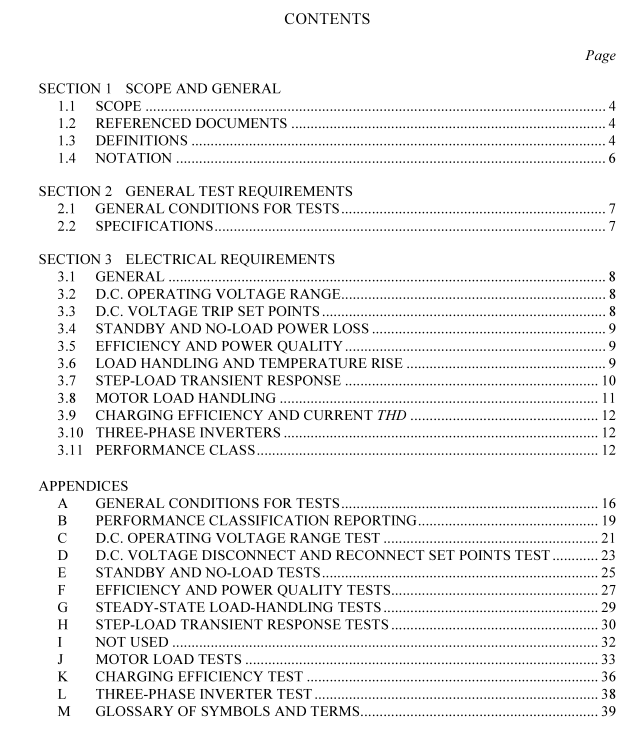AS NZS 5603 pdf download – Stand-alone inverters—Performance requirements

AS NZS 5603 pdf download – Stand-alone inverters—Performance requirements
3.1 GENERAL This Section sets out the electrical performance requirements for inverters intended to operate as stand-alone power systems. Appendix B provides an example of a performance classification schedule for the use of manufacturers when reporting on their product’s performance and ratings as determined by testing according to this Standard.
3.2 D.C. OPERATING VOLTAGE RANGE The d.c. operating voltage range shall be as declared by the manufacturer. The inverter’s nominal a.c. output voltage, output voltage harmonic distortion and output frequency shall be within the manufacturer’s specifications at any voltage within the d.c. operating voltage range as declared by the manufacturer. The inverter’s maximum and minimum operating voltage set points shall allow the unit to operate within the d.c. operating voltage range specified by the manufacturer. Compliance shall be verified by type testing in accordance with Appendix C.
3.3 D.C. VOLTAGE TRIP SET POINTS
3.3.1 D.C. overvoltage set points The inverter high voltage disconnect and reconnect set points shall be declared by the manufacturer or be adjustable. The high voltage disconnect and reconnect voltage, if applicable, shall agree with the set points within ±2%. Compliance shall be determined by type testing in accordance with the d.c. voltage disconnect and reconnect set points test described in Appendix D. If the unit has adjustable set points, the default values, or a set point agreed with the client or manufacturer, should be used for testing purposes. Where the inverter manufacturer has specified a temperature corresponding to the set points, this temperature shall be used as the reference temperature for the test. Where the inverter manufacturer has not specified such a temperature, a reference temperature of 25°C shall be used. Where the inverter manufacturer has specified a temperature coefficient for the set points, the inverter shall be tested with the battery temperature sensor at the reference temperature and at 40°C. NOTE: Disconnect and reconnect overvoltage set points are often used in stand-alone power systems with batteries to protect the battery from overvoltage conditions.
3.3.2 D.C. under-voltage set points The inverter shall have low input voltage disconnect and reconnect set points. These set points shall be declared by the manufacturer or be adjustable. The low voltage disconnect and reconnect voltages shall agree with the set points within ±2%. Compliance shall be determined by type testing in accordance with the d.c. voltage disconnect and reconnect set points test described in Appendix D. If the unit has adjustable set points, the default values, or a set point agreed with the client or manufacturer, should be used for testing purposes.
Where the inverter manufacturer has specified a temperature corresponding to the set points, this temperature shall be used as the reference temperature for the test. Where the inverter manufacturer has not specified such a temperature, a reference temperature of 25°C shall be used. Where the inverter manufacturer has specified a temperature coefficient for the set points, the inverter shall be tested with the battery temperature sensor at the reference temperature and at 40°C. NOTE: Disconnect and reconnect under-voltage set points are required in stand-alone power systems with batteries to protect the battery from under-voltage conditions.
3.4 STANDBY AND NO-LOAD POWER LOSS The inverter shall comply with the no-load power and standby power (where applicable) loss limits as specified in Clause
3.11 and Tables 4 and 5 when an input voltage equivalent to 110% of the d.c. nominal input voltage is applied on the d.c. terminals. P ACTIVE and P STANDBY shall be within 15% of P ACTIVE-SET and P STANDBY-SET respectively. Compliance and classification shall be verified by type testing in accordance with Appendix E.
3.5 EFFICIENCY AND POWER QUALITY The inverter efficiency, output voltage total harmonic distortion and output voltage regulation shall be assessed on the basis of the limits specified in Clause 3.11 and Tables 6 to 8. The output frequency limits shall be ±3 Hz from the nominal frequency as declared by the manufacturer. Measurements shall be made in accordance with the test schedule specified in Table 1. Compliance and classification shall be assessed by type testing in accordance with Appendix F.









